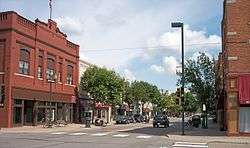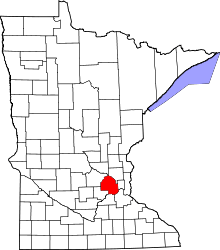Hopkins, Minnesota
| Hopkins | ||
|---|---|---|
| City | ||
| Hopkins, Minnesota | ||
|
Downtown Hopkins | ||
| ||
 Location of Hopkins within Hennepin County, Minnesota | ||
| Coordinates: 44°55′50.77″N 93°24′6.09″W / 44.9307694°N 93.4016917°WCoordinates: 44°55′50.77″N 93°24′6.09″W / 44.9307694°N 93.4016917°W | ||
| Country | United States | |
| State | Minnesota | |
| County | Hennepin | |
| Founded | 1852 | |
| Incorporated | 1893 (as West Minneapolis) | |
| Incorporated | January 1, 1948 (as Hopkins) | |
| Government | ||
| • Mayor | Gene Maxwell | |
| Area[1] | ||
| • Total | 4.11 sq mi (10.64 km2) | |
| • Land | 4.08 sq mi (10.57 km2) | |
| • Water | 0.03 sq mi (0.08 km2) | |
| Elevation | 1,030 ft (314 m) | |
| Population (2010)[2] | ||
| • Total | 17,591 | |
| • Estimate (2015)[3] | 18,076 | |
| • Density | 4,311.5/sq mi (1,664.7/km2) | |
| Time zone | Central (CST) (UTC-6) | |
| • Summer (DST) | CDT (UTC-5) | |
| ZIP codes | 55305, 55343, 55345 | |
| Area code(s) | 952 | |
| FIPS code | 27-30140[4] | |
| GNIS feature ID | 0645180[5] | |
| Website | City of Hopkins | |
Hopkins is a suburban city in Hennepin County, Minnesota, United States, located west of Minneapolis. The city is four square miles in size and is surrounded by the larger, west suburban communities of Minnetonka, Saint Louis Park, and Edina. Hopkins is about 98% developed with little remaining vacant land. The population was 17,591 at the 2010 census.[6]
U.S. Highway 169 and Minnesota State Highway 7 are two of the main routes in the area.
Geography
According to the United States Census Bureau, the city has a total area of 4.11 square miles (10.64 km2), of which 4.08 square miles (10.57 km2) is land and 0.03 square miles (0.08 km2) is water.[1] There are several small ponds on the western side of Hopkins, and creeks to the north and south. One of these creeks includes Minnehaha Creek. The north branch of Nine Mile Creek has its headwaters in Hopkins at the intersection of 13th Avenue South and Excelsior Boulevard.
Demographics
| Historical population | |||
|---|---|---|---|
| Census | Pop. | %± | |
| 1900 | 1,648 | — | |
| 1910 | 3,022 | 83.4% | |
| 1920 | 3,055 | 1.1% | |
| 1930 | 3,834 | 25.5% | |
| 1940 | 4,100 | 6.9% | |
| 1950 | 7,595 | 85.2% | |
| 1960 | 11,370 | 49.7% | |
| 1970 | 13,428 | 18.1% | |
| 1980 | 15,336 | 14.2% | |
| 1990 | 16,534 | 7.8% | |
| 2000 | 17,145 | 3.7% | |
| 2010 | 17,591 | 2.6% | |
| Est. 2015 | 18,076 | [7] | 2.8% |
| U.S. Decennial Census[8] 2015 Estimate[3] | |||

2010 census
As of the census[2] of 2010, there were 17,591 people, 8,366 households, and 3,975 families residing in the city. The population density was 4,311.5 inhabitants per square mile (1,664.7/km2). There were 8,987 housing units at an average density of 2,202.7 per square mile (850.5/km2). The racial makeup of the city was 70.4% White, 13.5% African American, 0.6% Native American, 8.5% Asian, 3.4% from other races, and 3.6% from two or more races. Hispanic or Latino of any race were 7.9% of the population.
There were 8,366 households of which 24.9% had children under the age of 18 living with them, 31.4% were married couples living together, 12.1% had a female householder with no husband present, 4.0% had a male householder with no wife present, and 52.5% were non-families. 43.4% of all households were made up of individuals and 11.5% had someone living alone who was 65 years of age or older. The average household size was 2.07 and the average family size was 2.93.
The median age in the city was 34.4 years. 21.1% of residents were under the age of 18; 8.4% were between the ages of 18 and 24; 34.3% were from 25 to 44; 23.4% were from 45 to 64; and 12.6% were 65 years of age or older. The gender makeup of the city was 47.6% male and 52.4% female.
2000 census
At the 2000 census,[4] there were 17,145 people, 8,224 households and 3,741 families residing in the city. The population density was 4,205.9 per square mile (1,622.5/km²). There were 8,390 housing units at an average density of 2,058.2 pe square mile (794.0/km²). The racial makeup of the city was 82.61% White, 5.19% African American, 0.78% Native American, 5.92% Asian, 0.09% Pacific Islander, 2.58% from other races, and 2.82% from two or more races. Hispanic or Latino of any race were 5.54% of the population. 23.9% were of German, 12.4% Norwegian, 7.4% Irish and 7.1% Swedish ancestry.
There were 8,224 households of which 22.7% had children under the age of 18 living with them, 31.4% were married couples living together, 10.5% had a female householder with no husband present, and 54.5% were non-families. 42.9% of all households were made up of individuals and 12.1% had someone living alone who was 65 years of age or older. The average household size was 2.03 and the average family size was 2.85.
19.6% of the population were under the age of 18, 10.7% from 18 to 24, 37.2% from 25 to 44, 18.0% from 45 to 64, and 14.5% who were 65 years of age or older. The median age was 34 years. For every 100 females there were 90.6 males. For every 100 females age 18 and over, there were 87.5 males.
The median household income was $39,203 and the median family income was $50,359. Males had a median income of $37,541 versus $30,687 for females. The per capita income for the city was $26,759. About 8.1% of families and 9.3% of the population were below the poverty line, including 12.3% of those under age 18 and 6.7% of those age 65 or over.
Housing
Hopkins has a much lower homeownership rate than neighboring communities. The city’s 39 percent homeownership rate is 22 percentage points less than the 61 percent of St. Louis Park, which has the next lowest rate among Hopkins’ neighbors.[9] Other west metro communities fall in the mid-70 percent range.
Housing also tends to be cheaper than most west metro communities. Hopkins’ $225,200 median value is the lowest among its neighbors.[9] The median housing value for St. Louis Park, which is next lowest, is 6.75 percent higher at $240,400.
Government
City charter
Hopkins’ government structure is set by its city charter. Hennepin County district court judges appointed the first Hopkins Charter Commission on February 8, 1946, in order to create a proposed charter that would be voted on.[10] The commission submitted the proposed charter to the Village Council on Nov. 4, 1947. Voters approved the charter Dec. 2, 1947. The charter has been amended numerous times since then, most recently in October 2012.[11]
Government Structure
The charter specifies that Hopkins use a council-manager plan. The council controls city administration but does so exclusively through the city manager.[12] The charter contains an “interference with administration” clause that expressly forbids the council from telling the city manager who to hire or preventing the city manager from using his or her judgment to make administrative appointments.[11] It also prohibits the council from issuing orders to any of the city manager’s subordinates.
Mayor and Council
The council is made up of the mayor and four council members elected at-large. The mayor serves a two-year term in office. Council members have four-year terms — with two of the seats on the ballot in one election and the other two seats up in the following election. Regular elections take place in odd years.
The mayor votes on all motions before the council like the council members. The position is also the head of the city for ceremonial purposes, serving legal processes and martial law.
The mayor is paid $6,000 per year and council members are paid $4,600 per year.[12] The current salaries were set in 1998.
Hopkins Presidents and Mayors[13]
| Presidents | Mayors |
|---|---|
| C.L. Hopkins (1893-1894) | Joseph Vesely (1948-1949) |
| Fred Souba (1895-1897) | W. Harlan Perbix (1950-1953) |
| D.E. Dow (1898) | Joseph Vesely (1954-1955) |
| Fred Souba (1899-1900) | Dr. F.M. Madden (1956-1957) |
| Paul Swenson (1901-1907) | W. Harlan Perbix (1958) |
| G.W. Moore (1908) | Donald Milbert (1961-1963) |
| Paul Swenson (1909) | John Hanley (1965-1969) |
| Emil Anderson (1910) | Henry Pokorny (1970-1975) |
| Paul Swenson (1911-1913) | Jerre A. Miller (1975-1981) |
| A.J. Hentschel (1914) | Robert F. Miller (1981-1985) |
| G.W. Moore (1915-1921) | Ellen Lavin (1985-1987) |
| J.W. Pemberton (1922) | Donald Milbert (1987-1989) |
| Paul Swenson (1923-1926) | Nelson W. Berg (1989-1993) |
| Anton A. Olson (1927-1928) | Chuck Redepenning (1993-1999) |
| M.B. Hagen (1929-1931) | Eugene Maxwell (1999–2015) |
| G.W. Moore (1932-1935) | Molly Cummings (2016-Present) |
| Anton A. Olson (1936-1937) | |
| E.V. Manchester (1938-1939) | |
| Dr. F.M. Madden (1940-1947) |
City Manager
The city manager is the chief administrator of the City of Hopkins. The Hopkins City Council appoints the city manager for an indefinite period and may remove the manager at any time.
Subordinate Employees
The charter specifies just two other administrative positions by name. It requires the city to have a clerk, who is subordinate to the city manager. It also allows for, but doesn’t require, a city attorney to advise the council on legal matters.
However, the charter specifies that the city manager can create city departments and divisions and alter them when necessary. Hopkins now has seven departments, each with a department head that reports to the city manager.[14] The departments are:
- Administration
- Community Services (Assessing, City Clerk, Inspections)
- Finance
- Fire
- Planning & Economic Development
- Police
- Public Works
- Recreation (operated jointly with Minnetonka, Minnesota)
History

The first settlers of Hopkins arrived in 1852[15] as land around the growing Minneapolis–Saint Paul area was opening up and being explored by members stationed at Fort Snelling. However, the roots of the town begin in 1887 with the building of the Minneapolis Threshing Machine Company, later called Minneapolis-Moline, to make farm equipment. At the time, Minneapolis Moline employed most of the Hopkins residents. In 1887, the West Minneapolis Land Company was founded and formed to build housing for the Minneapolis Moline factory workers.
In 1893, residents of Hopkins sent the Hennepin County Board of Commissioners a petition signed by 41 residents, asking that a separate village be formed from unincorporated portions of then-Minnetonka and Richfield Townships. Following an election, the community was then incorporated as the Village of West Minneapolis with a population of 1,105. The original village consisted of about three square miles, and it has been enlarged by annexation to its present size of about four square miles.
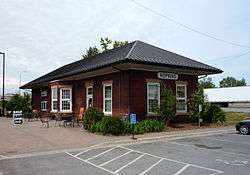
In 1928, the name of the village was changed to Hopkins after Harley H. Hopkins, who was among its first homesteaders and was the community's first postmaster. Mr. Hopkins allowed the town to build the train depot on his land (now The Depot Coffee House) with the agreement that the train station would say "Hopkins" on it. People getting off the train assumed the name of the town was Hopkins and it stuck. On January 1, 1948, the village became the city of Hopkins, upon adoption of a council–city manager charter.
Timeline
- 1852 – First settlers arrived
- 1862 – First school, Burnes, built
- 1887 – Minneapolis Threshing Machine Company built
- 1893 – November 7, 1168 people incorporated the village of West Minneapolis
- 1893 – December 9, first city-council elected
- 1899 – Streetcar arrived in Hopkins
- 1928 – July 7, village name changed to Hopkins
- 1929 – Minneapolis Threshing Machine Company becomes Minneapolis-Moline
- 1934 – Hopkins business people organized the first Hopkins Raspberry Festival
- 1947 – December 2, Hopkins became a city through the adoption of a city charter
Hopkins Raspberry Festival
The Hopkins Raspberry Festival is an annual event in Hopkins. The Hopkins Raspberry Festival was founded in 1935 as a way to boost business during the Great Depression of the 1930s. A date of July 21 was chosen to hold the event to coincide with the peak of raspberry-picking season. The festival now takes place the third weekend in July every year.
The Raspberry Festival is overseen by a board of directors supported by many additional volunteers and local civic organizations each year. Most of the volunteers return from year to year, with some being active for as many as 20 years. Since its inception, it has evolved into a dynamic community celebration with activities including music, sporting events, royalty coronations, craft fair, and parade.
Education
Public schools
The Hopkins School District serves all or parts of seven Minneapolis west suburban communities: Hopkins, Minnetonka, Golden Valley, Plymouth, Edina, Eden Prairie, and Saint Louis Park. Approximately 8,100 students attend seven elementary schools (K–sixth grade), two junior high schools (7th–9th grade), and one high school (10th–12th grade). Some students attend public schools in other school districts chosen by their families under Minnesota's open enrollment statute, as some students from outside Hopkins school district enroll in Hopkins schools on that basis.[16]
| Schools in the Hopkins School District | ||
|---|---|---|
| Elementary schools | Junior high school | Senior high school |
| Alice Smith Elementary | Hopkins West Junior High[1] | Hopkins High School[1] |
| Eisenhower Elementary | Hopkins North Junior High [1] | |
| Gatewood Elementary[1] | ||
| Glen Lake Elementary[1] | ||
| Katherine Curren Elementary (Closed and being rented) | ||
| Meadowbrook Elementary[2] | ||
| L.H. Tanglen Elementary[1] | ||
- ^ located in Minnetonka
- ^ located in Golden Valley
Private schools
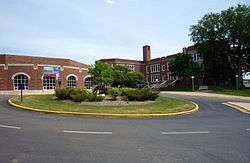
There are five private schools in Hopkins:
- The Blake School: A large private school with several campuses throughout the Twin Cities was originally founded in Hopkins, and the Blake Campus in the city houses both the Middle School and one of its two Lower Schools.
- Hopkins Montessori School
- St. David's School: A preschool and child development center
- Agamim Classical Academy
- St. John's Catholic School
Charter schools
- Mainstreet School of Performing Arts (MSSPA): A performing arts school that focuses on the three major performing arts areas; music, dance and theater. The school opened in 2004. Grades 9–12.
- Ubah Medical Academy is a charter high school currently leasing space in the Katherine Curren Elementary building. The school was chartered in 2003 and was previously housed in Minneapolis.
- International Spanish Language Academy(ISLA): A K-6 Spanish immersion community (founded in 2007)
Notable people
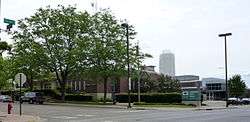
This is a representative, not a definitive list of people from Hopkins, Minnesota, who have had a unique impact on the community and in many instances beyond the area, state, and nation.
- L. Thomas Aldrich – (1817–1913) Geophysicist - was known worldwide for his work as a geophysicist and geochemist at the Carnegie Institute for Science's Department of Terrestrial Magnetism as part of a research team that pioneered the development of methods and instruments for determining the age of rocks through dating their constituent minerals.[17]
- Nate Berkus - Interior designer,author,TV host and personality, featured on the Oprah Winfrey television show. His Chicago interior design firm, Nate Berkus Associates has issued a variety of product lines including a collaboration with the Target retail stores on a 150 piece line of home interior items - bedding,lighting, rugs,etc.
- Catherine (MacDonald) Blake – President of National Auxiliary American Medical Association. She became a powerful force in public health and nursing movements and was very active in the Red Cross.
- Dr. James Blake, Sr. – Prominent Hopkins pioneer and physician. Established early "clinic" approach to his practice. Three of his sons became doctors and his two daughters became nurses.
- Aaron Brown – American broadcast journalist on ABC and CNN.[18] Most recognized for his coverage of the September 11, 2001 attacks.
- Dr. Catherine Burnes – First doctor to serve the Hopkins area and first female to graduate from the University of Minnesota Medical School. Practiced medicine from 1886 - 1917.
- Walter Bush – As a national leader in the growth and development of amateur and professional hockey elected to the U. S. Hockey Hall of Fame in 2000.
- Tim Carr - Music critic, writer and promoter. A&R (Arts and Repertoire) executive for Capitol Record, Warner Brothers Record and DreamWorks.[19]
- David Carr – Media and culture columnist for The New York Times.[20] Author of a memoir and best seller ‘’The Night of the Gun.’’ Early in his journalist career he was the editor of the ‘’Twin Cities Reader,’’ a weekly alternative newspaper in Minneapolis.
- James Cramer – Executive Director of the American Institute of Architects of Minnesota. Then moved to Washington D.C. as the Executive Director of the American Institute of Architects of the USA.
- Ernie Fliegel – Professional prize fighter, a founder of the 620 Club bar and restaurant (1933-65) in Minneapolis.[21]
- Thomas Forbes – Engineer, inventor - Conceived uses for gyroscopes to stabilize ships, toys, and other uses including patents used in aircraft auto pilots. Invented an automatic toaster and electric blanket controls.
- Mark Forgy - Artist assistant and author.Traveling on the Spanish Mediterranean island of Ibiza in 1969 he met and became the personal assistant of a Hungarian artist, Elmyr de Hory, who had a flamboyant career as a great and prolific forger of the work of modern artists including Picasso,Modigliani,Matisse and many others. Mentored by and participating in the last seven years of de Hory's life, Mark wrote a detailed biography of this remarkable artist," The Forger's Apprentice, Life With The World's Most Notorious Artist" published in 2012. Mark inherited three hundred of de Hory's works and returned to live in Minnesota.
- William E. Gardner, PhD – Educator/Historian - Professor of secondary education, chairman of the department, and dean at the University of Minnesota. Authored a number of books and articles in the area of education, history and social studies.
- Daniel Grodnik - Movie producer, Chairman of the Board/CEO of Mass Hysteria Entertainment. He has been an active force in the independent film industry. Working with every major studio he has produced more than forty motion pictures and television movies including the Golden Globe best picture nomination, "Bobby" , about the last day of Robert Kennedy's life. He is currently teaming with Remark Films, a production company, to finance 2-5 feature films a year
- Harley H. Hopkins – (1823–1882) First railroad station master and postmaster - A direct descendant of Stephen Hopkins, one of the 26 signers of the Declaration of Independence.[22]
- John Hardgrove – Wisconsin State Assemblyman.
- Samantha Harris – Television hostess and actress. Her most prominent role was as E! Entertainment correspondent and a Dancing with the Stars co-host.
- Archie Japs – (1913–2003) Graduated from Hopkins High School in 1929 at the age of 15 and then at the age of 19 graduated from the University of Minnesota with a degree in chemical engineering. This fast start did not slow during his 43 years at B. F. Goodrich. One of his first inventions was PVC, followed by seven patents for vinyl and solid propellants.
- John B. Keefe Sr. – Member of the Minnesota House of Representatives, Senate, Hennepin County Board Commissioner and a Municipal Court Judge.[23]
- Greta Kessenich – A scholar of peonies authoring several books on the subject. Secretary-Treasurer of the American Peony Society and editor of the quarterly "Peony Bulletin'.
- Arthur Kleiner – Musical Director for the Museum of Modern Art Film Department. At that time “world's only full-time pianist for silent films.” Pianist and composer for George Balanchine and Agnes DeMille. Active with Walker Art Center and Guthrie Theatre. In 1979 he received the "Film Band in Gold" from the West German government for "many years and exceptional activity in German film". His collection of music scores and manuscripts for almost 700 silent films was donated to the University of Minnesota in 1981.[24]
- Harry Leathers – Built one of the area's first automobiles in 1895.
- Michael Lehan – American football player (cornerback) for the Miami Dolphins.[25] A defensive cornerback who graduated from the University of Minnesota. He played for the Miami Dolphins and several other NFL teams.
- Russell S. (Butsie) Maetzold – Exceptional Hopkins High School football and basketball coach. Football - 88 wins - 6 losses and 5 ties. Basketball 508 wins and 62 losses.[26]
- James Markham – (1897–1963) Owned and operated the Hennepin County Review weekly newspaper from his office in Hopkins.[27] In 1934 and 1935, Markham was named one of 11 “All American Newspaper Editors.” He was named President Emeritus of the Minnesota Newspaper Association. Markham was a friend and political mentor of Hubert Humphrey.
- Archie H. Miller – Born June 8, 1886, the third generation of Millers in Hopkins. His grandfather was the first white settler on the west bank of the Mississippi River. The grandfather, J. P. Miller, then homesteaded in Hopkins in 1852. It was, yes, a log cabin where Archie's father, Frank, was born. Archie started his community life in Hopkins and was elected to 4 terms as City Clerk, Hopkins School Board, and Minnesota State Senate in 1930 where he served as majority leader until his death in 1958. Archie served as Lieutenant Governor from May 1943 to January,1945 during WWII. His legislative commitment involved transportation; expansion of the roads system led to the 'Beltline Road' to allow traffic to circle the Minneapolis expansions and to move commerce more efficiently. It was the first city freeway idea.
- Bloomie Mountain – For over 30 years, she with the assistance of Helen Kron, Mary Bastendorf, Hilda Johnson and others provided public library service to the community from the historic Dow mansion.[28]
- Jerry Noyce – University of Minnesota tennis coach for 15 years compiling a 260-132 (633%) and three Big Ten championships.- inducted into Intercollegiate Tennis Association (ITA) Collegiate Tennis Hall of Fame.[29] In 2007, he was one of 20 people appointed to the President's Council Sports and Fitness.[30]
- Dale R. Olseth – President and CEO of Tonka Corporation, Medtronic Inc and SurModics. "He demonstrated an extraordinary commitment to community and ethical leadership" as recognized by the University of Minnesota Board of Regents in 2004.[31]
- Vance K. Opperman – Chairman of the Board and CEO of Key Investment, Inc. He has served as President and CEO of West Publishing and Chairman of the Board of Blue Cross & Blue Shield of Minnesota as well as a board member of a number of other companies such as TCF Financial.[32]
- BeBe Shopp – Miss America - 1948. Noted for her expertise on the Vibraharp. First Miss American to travel abroad and to be crowned in an evening gown, not a swim suit. In 2009 she and five of her "Pageant Sisters" went to Afghanistan to entertain and support the troops. For the past few years, she has lent her talents performing and staging shows for "Share The Music," which produces programs from the American Song Book and Broadway.
- Steve Simon - Minnesota Secretary of State. After serving four terms as Hopkins Representative in the Minnesota Legislature, Steve was elected to a four-year term as Secretary of State taking office in January 2015. In prior years he also served as Assistant Minnesota State Attorney General and as an associate in the Minneapolis law firm, Robins,Kaplan, Miller and Ciresi.
- Jerry Slavin – Minnesota Golden Gloves champion boxer - Successful in the professional ring. Fought 22 bouts- won 18, draw - 2, lost - 2. In the Minnesota Boxing Hall of Fame.[33]
- Peter Smith – A veteran advertising man. He writes magazine articles, fiction and poetry and has been a commentator on Minnesota Public Radio's "Morning Edition,” and in the Minneapolis StarTribune and other venues. The "Morning Edition" segments resulted in a book about Minnesota life, "A Porch Sofa Almanac" and later he wrote a memoir, "A Cavalcade of Lesser Horrors.[34]
- Frank Stodola, PhD – Scientist/Biochemist who played a leading role in the development of penicillin in the early 1940s which was effectively used to combat infections during WWII.[35]
- Paul Swenson – Head of Minneapolis Threshing Machine Company (later known as Minneapolis Moline), banker, community leader, four time president/mayor of Hopkins.[36]
- Annette Turngren – The October 20, 1938 the Hennepin County Review newspaper announced Annette Turngren, a writer of seven books, had just returned from Sweden where she gathered material for a new novel. Her Flaxen Braids novel was, and still is, widely read. It is a story of what established her as a teller of experiences growing up in Sweden and as immigrants here in Minnesota. Her mother wrote poems and “sketches” which were published in Swedish magazines. Annette never tired of reminding folks she was from Hopkins and couldn’t wait to come back home.
- Joseph C. Vesely – Mayor, civic leader, secretary of 1934 Hennepin County Emergency Relief Administration, chaired a WWII Regional War Powers Office. Hopkins City Attorney, longtime president of the Hopkins Library Board. Member of the University of Minnesota Debate Team.
- W. Robert Worrell – Award winning industrial designer. In 1976 Bob and wife, Judy, founded Worrell Design Inc. which has designed 35 medical devices approved by the U.S. Food and Drug Administration (FDA). These designs include diabetes management tools to infusion devices, heart valves, cardiac pacemakers and defibrillators and others awaiting approval. While a substantial portion of the firm's output are medical products, other designs include the ubiquitous "smart straw" on cans of WD-40 and the long lived logo found on Bob Cat Inc. loaders.
References
- 1 2 "US Gazetteer files 2010". United States Census Bureau. Retrieved 2012-11-13.
- 1 2 "American FactFinder". United States Census Bureau. Retrieved 2012-11-13.
- 1 2 "Population Estimates". United States Census Bureau. Retrieved June 13, 2016.
- 1 2 "American FactFinder". United States Census Bureau. Retrieved 2008-01-31.
- ↑ "US Board on Geographic Names". United States Geological Survey. 2007-10-25. Retrieved 2008-01-31.
- ↑ "2010 Census Redistricting Data (Public Law 94-171) Summary File". American FactFinder. U.S. Census Bureau, 2010 Census. Retrieved 23 April 2011.
- ↑ "Annual Estimates of the Resident Population for Incorporated Places: April 1, 2010 to July 1, 2015". Retrieved July 2, 2016.
- ↑ United States Census Bureau. "Census of Population and Housing". Retrieved November 25, 2014.
- 1 2 "Community Profile". Retrieved 1 December 2013.
- ↑ "City Charter". Retrieved 1 December 2013.
- 1 2 "Charter of the City of Hopkins, Minnesota" (PDF). Retrieved 1 December 2013.
- 1 2 "City Council Structure & Salaries". Retrieved 1 December 2013.
- ↑ Hopkins Historical Society; Beverly O. Ewing, Editor (2002). Hopkins Minnesota Through the Years. Hopkins, Minnesota: Hopkins Historical Society. ISBN 0-9727014-0-0.
- ↑ "City Departments". Retrieved 1 December 2013.
- ↑ City of Hopkins website, City History webpage
- ↑ "Open Enrollment". Minnesota Department of Education. Retrieved 19 November 2010.
- ↑ Matt Schudel (9 May 2013). "L. Thomas Aldrich, geophysicist". The Washington Post. Retrieved 25 November 2013.
- ↑ Aaron Brown
- ↑ Reed Fischer (11 April 2013). "Tim Carr, local music critic and A&R rep, dead at 57". Retrieved 25 November 2013.
- ↑ Aaron Sorkin (June 2011). "Culture: David Carr". Interview. Retrieved 31 December 2011.
- ↑ "Ernie Fliegel". Retrieved 25 November 2013.
- ↑ "History". Retrieved 26 November 2013.
- ↑ "Keefe, Sr., John B.". Retrieved 25 November 2013.
- ↑ "Arthur Kleiner Collection of Silent Movie Music". Retrieved 26 November 2013.
- ↑ Michael Lehan
- ↑ "State Tournament Bests - Top 5 Boys' Coaches". Retrieved 25 November 2013.
- ↑ "Newspaper Milestones". Retrieved 25 November 2013.
- ↑ "History of the Hopkins Library" (PDF). Retrieved 26 November 2013.
- ↑ "ITA Men's Hall of Fame". Retrieved 25 November 2013.
- ↑ "President Bush Names Health Fitness Corp. CEO Jerry Noyce as Member of President's Council on Fitness and Sports". Retrieved 25 November 2013.
- ↑ "Dale R. Olseth". Retrieved 26 November 2013.
- ↑ "Vance Opperman". Forbes. Retrieved 26 November 2013.
- ↑ "Jerry Slavin". Retrieved 26 November 2013.
- ↑ "A Cavalcade of Lesser Horrors: Author Bio". Retrieved 26 November 2013.
- ↑ "Reflections: An unsung World War II hero from Hopkins". 19 December 2011. Retrieved 26 November 2013.
- ↑ "From the Vaults: The Building Blocks of Hopkins". 11 February 2011. Retrieved 26 November 2013.
External links
| Wikimedia Commons has media related to Hopkins, Minnesota. |
| Wikivoyage has a travel guide for Hopkins, Minnesota. |
- Official City Website
- Hopkins School District 270
- Hopkins Historical Society
- Hopkins Raspberry Festival
- U.S. Geological Survey Geographic Names Information System: Hopkins, Minnesota
